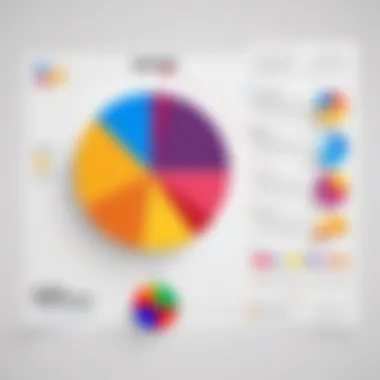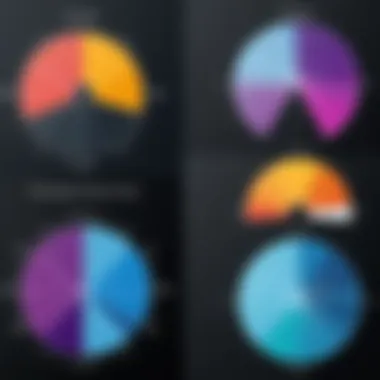Identifying the Largest Fraction: A Detailed Study


Intro
Understanding fractions is critical in both academic settings and practical applications. Whether for students tackling complex math problems or professionals needing clear data analysis, grasping how to identify the largest fraction can significantly enhance comprehension and arithmetic proficiency. This section will outline the fundamental principles involved in fraction comparison and set the stage for the detailed analysis to follow in subsequent sections.
Through careful exploration, this article aims not just to describe methodologies, but to engage readers with insights into effective problem-solving techniques. Complex comparisons may often be simplified through common denominators and visual representations. Such tools will be discussed in context to solidify understanding.
The implications of mastering fraction comparison extend into various fields, highlighting its relevance beyond mere numbers. This knowledge can empower readers to analyze real-world data, providing them with a sophisticated perspective on handling fractional values. Overall, this journey lays the groundwork for a comprehensive understanding of identifying the largest fraction, guided by applicable strategies and analytical frameworks.
Understanding Fractions
Understanding fractions is essential in mathematics. They serve as a bridge between whole numbers and divisions, enabling a nuanced comprehension of quantities. This makes fractions crucial in varied applications, from academic settings to everyday life. The ability to interpret and manipulate fractions allows individuals to handle data, solve problems, and make informed decisions. In this article, we delve into fractions, emphasizing their comparison to identify the largest value among them.
Definition of Fractions
A fraction represents part of a whole. It comprises two components: the numerator and the denominator. The numerator indicates how many equal parts are being considered, while the denominator indicates the total number of equal parts that make up the whole. This clarity in definition simplifies complex arithmetic into manageable segments, allowing for easier calculations and decisions. Therefore, understanding fractions lays the groundwork for more advanced mathematical operations.
Types of Fractions
Fractions come in various forms, each with distinct characteristics and applications:
Proper Fractions
Proper fractions are defined where the numerator is less than the denominator. A key characteristic is that they always signify a value less than one. Proper fractions are widely used in various mathematical contexts and have simple conversions. Their unique feature lies in straightforward visual and numerical representations, which enhance understanding and analysis. In scenarios with fraction comparison, proper fractions allow for direct insight, fostering a deeper comprehension of relative sizes and their applications in numerous situations, whether academic or practical.
Improper Fractions
Improper fractions, in contrast, occur when the numerator is greater than or equal to the denominator. This characteristic leads to values of one or greater, making them fundamental when representing quantities exceeding a whole. The main advantage of improper fractions is their utility in mathematical operations, particularly in addition and subtraction. Techniques for managing improper fractions often lead to more insightful comparisons when cross-evaluating diverse sets, contributing meaningfully to our overall understanding of fraction sizes.
Mixed Numbers
Mixed numbers combine whole numbers with fractions, indicating a value greater than one but expressed in a more user-friendly format. Their unique feature is that they bridge the gap between whole and fractional values, making them easier to comprehend. Mixed numbers can simplify complex calculations and provide intuitive sense in practical applications, such as cooking or building projects. They remind when comparing fractions that various styles can exist, ensuring a broader scope of understanding.
Fraction Comparison Fundamentals
Understanding how to compare fractions is vital in mastering not only mathematical concepts but also practical applications in our daily lives. The art of fraction comparison serves as the foundation for various mathematical skills. It allows individuals to ascertain differences, make choices guided by numerical values, and tackles challenges requiring a strong grasp of proportion.
In this section, we will delve deeper into the significance of comparing fractions, highlighting its various facets.
What Does it Mean to Compare Fractions?
To compare fractions means to assess their sizes relative to one another. This process involves evaluating the ratio between the numerator, the top number, and the denominator, the bottom number, by determining which fraction is greater, smaller, or if they hold equivalent values.
The three most common techniques for doing this are:
- Finding a common denominator
- Applying the cross-multiplication technique
- Converting to decimal form
Many people perceive fraction comparison as a straightforward process. However, without proper understanding, one can easily misjudge outcomes. Hence, a deeper understanding of each method cultivates clarity and confidence in the approach.
Importance of Comparing Fractions
The act of fraction comparison extends beyond academic exercises; its implications can influence critical decision-making. In assessing overall purchasing power or analyzing data trends, one may calculate values expressed as fractions.


- Decision Making: Often, choices involve analyzing multiple options. Thus, understanding how to interpret which fraction is larger directly affects outcomes.
- Problem Solving: Fraction comparisons are pervasive in math. From basic arithmetic to advanced problem scenarios, competency in this area empowers individuals to navigate situations efficiently.
- Real-World Applications: Situations like recipe adjustments, budgeting, or even understanding discounts revolve around effective fraction comparison. Enhancing skills in this area allows for improved financial literacy.
Comparing fractions equips one with the skill set necessary to tackle various math-related challenges and live more thoughtfully in real-world situations.
By grasping the fundamental components of fraction comparisons, learners are better equipped to explore more advanced concepts in mathematics. Thus, embedding these principles early on fortifies one's overall mathematical foundation.
Methods for Comparing Fractions
Understanding the methods for comparing fractions is crucial, as it provides the foundational skills needed to identify the largest fraction easily. Each technique has its unique advantages and specific considerations that could affect the outcome. By integrating these methods into mathematical practice, individuals can build confidence in their ability to handle fractions effectively, which can be particularly useful in a variety of real-world scenarios.
Finding a Common Denominator
Finding a common denominator is a traditional method often used for comparing fractions. A common denominator is a multiple of both denominators, allowing the fractions to be rewritten with matching denominators. This makes it straightforward to evaluate which fraction is larger.
- Identify the Denominators: Look at each of the fractions.
- Calculate the Least Common Multiple (LCM): Find the smallest multiple common to both denominators.
- Convert Fractions: Rewrite each fraction so they share the common denominator.
- Compare Numerators: Assess which numerator is larger to conclude which fraction is bigger.
This method works well with both proper and improper fractions; however, finding the least common multiple can be time-consuming, especially with larger numbers.
Cross-Multiplication Technique
Cross-multiplication offers a quicker alternative to compare fractions, especially in situations where finding a common denominator may not be practical. It involves multiplying the numerator of one fraction by the denominator of the other.
- If two fractions are A/B and C/D:
- Cross multiply to obtain: A * D and B * C.
- Calculate: Multiply A by D and B by C.
- Assess the Results: - If A * D > B * C, then A/B is greater than C/D.
- If A * D B * C, then A/B is less than C/D.
This method is often faster and requires fewer calculations than finding a common denominator, but clarity in multiplication is important to avoid errors.
Decimal Conversion Approach
The decimal conversion approach is another method for comparing fractions, which involves converting fractions into decimal format. This method works well for visualizing the relative size of fractions clearly.
- Divide Numerator by Denominator: For fraction A/B, perform A ÷ B.
- Repeat for Other Fractions: Do the same for C/D.
- Compare Decimals: Assess which decimal value is larger to find the larger fraction.
Beyond simplicity, this technique helps in readily recognizing the size of the fractions, particularly when using calculators or software that handles decimal calculations well. However, decimals can sometimes introduce rounding errors that could affect comparison outcomes, making precision key.
Visual Representations of Fractions
Visual representations of fractions are essential for gaining a deeper understanding of their mathematical significance and comprehending their relational value. Through these visual aids, complex numerical comparisons become simpler, allowing individuals—at any skill level—to appreciate the nuances of fractions better. They aid not only in identifying the exact size of a fraction but also facilitate quicker and intuitive comparisons among multiple fractions. When visual tools communicate ideas effectively, learning becomes more engaging and productive.
Using Fraction Bars
Fraction bars are a powerful visual tool that illustrates the relationships between different fractions. Generally, these bars consist of rectangular segments divided into portions that represent various fractional values. For instance, a bar divided into four equal parts can show fractions such as 1/4, 2/4, and 3/4 clipped directly in line with their size deductions.
The beauty of fraction bars lies in their simplicity and accessibility; they allow a learner to see how quantities stack metaphorically when looking for the largest or smallest fraction. A crucial benefit of employing fraction bars is their ability to clarify the idea that fractions can be equivalent despite appearing different. Manipulating these bars physically, or even digitally on screen, provides a more engaging way to grasp abstract mathematical concepts of fractions.
Visual representations like fraction bars can turn abstract ideas into comprehensible concepts for all students.


When implementing fraction bars in learning, consider the following:
- Use colored segments to differentiate between numerators and denominators.
- Present mixed data sets to allow learners to visually acquire contrasts.
- Include various sizes and combinations to drive points home about equivalent fractions.
Pie Charts and Fractions
Pie charts offer another form of visual fraction representation where the whole is displayed as a circle divided into slices. Each slice signifies a specific fraction, showing immediate how pieces compare in size. This circular model is particularly adept at illustrating proportions and part-to-whole relationships.
One inherent advantage of pie charts is their effectiveness in highlighting large differences and common parts between fractions. For example, in comparing the fractions 1/2 and 3/8, one slice can represent each value in a clear, visual manner, emphasizing that 1/2 is larger than 3/8 without requiring arithmetic comprehension.
When using pie charts, it's essential to maintain clarity and simplicity; this aids in correct interpretation. Key considerations include:
- Ensure slices are labeled efficiently for reduced confusion.
- Limit the number of fractions represented to retain clarity in visual output.
- Cycle graphs to animate changes in fractions when applicable to emphasize changes visually over time.
Practical Applications of Comparing Fractions
Understanding how to compare fractions extends beyond theoretical mathematics. Practical applications exist in various fields, addressing real-world needs and fostering better decision-making skills. Knowing how to identify the largest fraction in a set serves not only as a cognitive exercise but also provides crucial insights into daily activities. Understanding these applications benefits anyone ranging from students to professionals.
Fractions in Cooking and Recipes
In culinary contexts, precise measurements are vital. Recipes frequently present fractions, compelling the cook to compare them effectively in order to achieve the desired result. For instance, if a recipe calls for 1/4 cup of sugar while another explicitly asks for 2/5 cup, understanding which fraction is larger is paramount. By knowing that 2/5 is greater than 1/4, it allows for appropriate adjustments when doubling or halving portions.
The practice of using fractions in cooking not only includes adding but also converting between fractions. Being able to recognize that ⅗ is less than ¾ can influence a recipe's flavor profile or overall balance significantly. Understanding these subtle distinctions can lead to better culinary outcomes and educate individuals on managing proportion calculations.
Mathematical Problems in Real-Life Situations
Outside the realm of cooking, fractions appear in various everyday scenarios requiring attention. Situations such as budget planning involve dealing with fractions when allocating funds or making financial comparisons. For instance, if someone is comparing how much is spent on utilities versus entertainment, understanding fractions can simplify decisions. In this case, knowing that 3/5 of the budget is designated for utilities might prompt an individual to reconsider discretionary spending.
Furthermore, workplace applications can include everything from analyzing data in reports to project timelines. For example, splitting project tasks among a team could invoke the need for using fractions to determine workload distribution. One team might be assigned 3/10 of the project, while another tackles 1/2, necessitating the ability to compare these figures effectively to achieve a balanced outcome.
Everyday scenarios highlights how fraction comparison is integral to conscious decision-making in numerous contexts.
Ultimately, the mastery of fractions enriches decision-making processes across numerous compartments of life.
Addressing Common Misconceptions
Understanding fractions involves more than just the ability to perform basic arithmetic operations. It extends to accurately interpreting and comparing fractions in various contexts. In this section, we tackle misconceptions that often lead to confusion when identifying the largest fraction. Recognizing these beliefs can greatly enhance your understanding and practical application of fraction comparison.
Beliefs About Larger Numerators
A common misconception is that a fraction with a larger numerator is always larger than one with a smaller numerator. Take for example the fractions 3/5 and 1/2. At first glance, one might assume that because 3 is greater than 1, it means 3/5 is larger than 1/2. However, this belief fails to account for the role of the denominator.
The denominator expresses how many equal parts a whole is divided into. In 3/5, the whole is divided into 5 parts, while in 1/2, it is divided into just 2 parts. Here, the relative sizes of fractions depend on both their numerators and denominators. To clearly establish which fraction is larger, using methods like finding a common denominator can provide clarity.
Key Insight: Always compare the fractions in terms of their denominators to get an accurate comparison, rather than focusing solely on numerators.
Misunderstanding Improper Fractions
Another widespread misunderstanding is related to improper fractions, which are those where the numerator is larger than the denominator, such as 7/4. Many learners mistakenly equate improper fractions to being larger than all proper fractions.
This perspective neglects the necessity of evaluating the total value of the fraction as a whole. For instance, while 7/4 has a value greater than 1, some proper fractions can still exceed it when evaluated within their specific ranges. For instance, 5/3 exceeds 7/4 when fraction values are being compared irrespective of their classification as proper or improper.


Understanding this distinction proves significant, especially in educational settings where clarity around type may influence a learner's mathematical confidence. Through practice and application in real-world scenarios, the importance of proper evaluation will become clearer.
Adjusting perspectives on improper fractions, and focusing on actual numerical values rather than their classifications,forms a refined approach to evaluating fractions.
Case Studies: Comparing Specific Fractions
The analysis of specific fraction comparisons is a fundamental component of this article. It handles various scenarios where fractions are applied in both theoretical frameworks and practical contexts. Through the examination of various fractions, readers will grasp the underlying concepts that dictate how to identify which among a set stands as the largest.
In selected case studies, we will probe into different types of fractions, their applications, and strategy. By observing these fractions closely, readers can learn techniques that span from basic understanding to advanced comparisons. This structured examination aids in seeing not just the mathematical side but also its relevance in everyday decision-making.
Examples based on real-life situations provide insight in evaluating fractions effectively. Overall, these case studies deepen the understanding of reduction techniques, common denominators, and several methods moving around fraction calculations.
Basic Fraction Sets
To maximally utilize basic fraction sets in comparisons, it’s crucial to start with simple examples. Using provided basic fraction skills can show how fundamental the concept is and help effectively sort through different values. These fractions typically consist of simple numerators and denominators. The clear simplicity in working through basic fractions creates an arena for myriad applications.
A typical fraction set could include fractions like 1/2, 1/3, and 2/5. Each of these will allow a meaninful analysis with relative ease in comparing their size. Let’s consider the following comparisons:
- 1/2 vs 1/3: Here, casual observation shows that 1/2 is larger than 1/3 because the denominator lowr greatly increases the value of the fraction.
- 2/5 vs 1/3: Using cross-multiplication to simplify the evaluation : 23=6 and 15=5 infers that 2/5 is greater than 1/3.
Such basic fractions are approachable to all learners, and these comparisons can lay the groundwork toward more advanced methods of analysis. Their standard representation sprouts a comprehension of fragments, establishing pathways for growth into more intricate fraction grasp.
Advanced Fraction Comparisons
When blending complexity and skill, advanced fraction comparisons go beyond simple evaluation. They introduce challenges, involving fractions that can obscure quick understanding. Specific techniques in this realm include intricate values, mixed numbers, and improper fractions. Advanced fractions like 5/8 and 7/10, or contrasting mixed numbers such as 2 1/4 and 1 3/5 illustrate the varied playing field.
In analyzing 5/8 and 7/10:
- By cross-multiplying, 510 = 50 and 78 = 56 implies 7/10 surpasses 5/8 in value.
- Look globally at larger sets. Here similarities in sections become increasingly important, delivering critical value. Not just in mathematics does this mesh larger significance. We're building soft skill in networking possibilities, too.
Each step enforces depth. By tackling advanced fraction situations, learners absorb versatile strategies. Analysis paired with experience equips readers for complex environments in professional or educational contexts, ultimately transforming basic skills into advanced, comprehensive understanding.
Through these case studies, potential misjudgments in larger numerator beliefs get tackled. It arms readers with resolved confidence as they learn how critical fraction size carries over into life situations. Understanding fractions now seems less abstract and more of a concrete skill that undeniably sees value wherever numbers meet.
Closure and Summary
In any mathematical discourse, specifically regarding fractions, summation of insights plays a crucial role. This conclusion serves not just as a wrap-up but as a reinforcement of the core concepts discussed in the preceding sections. The process of identifying and comparing fractions forms a backbone of mathematical accuracy necessary for both students and professionals alike.
When engaging in fraction comparison, understanding the framework — including definitions and methodologies — provides clarity. Readers who invest time in mastering these concepts gain enhanced abilities in evaluating numerical relationships. This capability extends beyond academia; it seeps into practical applications such as budgeting and problem-solving. Knowledge of fractions is often pivotal, making tasks easier, more intuitive, and less prone to error.
Interestingly, overcoming common misconceptions and learning methods such as finding common denominators or employing cross-multiplication aids comprehension significantly. These skills foster a deeper understanding of mathematics and improve overall numerical fluency, which is increasingly valued in today's data-driven world.
Effective understanding of fraction comparison paves ways to accurate decision making in academic and real-world situations.
Having extracted essential lessons from the article, readers are encouraged to apply these techniques consistently. This will not only solidify individual understanding but also keep ahead in fields of study dependent on precise calculations.
Key Takeaways
- Fractions represent a fundamental element in mathematics and daily life, serving numerous purposes.
- Understanding how to compare fractions correctly is essential for accurate interpretation of numerical data.
- Common approaches to fraction comparison include utilizing common denominators, cross-multiplication, and decimal conversions, each contributing its benefits.
- Misconceptions must be addressed in learning to enhance clarity about how fractions function within defined parameters.
- Practical applications demonstrate the real-world significance of learning these concepts, from cooking measurements to technical calculations.
Future Implications of Fraction Comparison Skills
The future of mathematical methods is increasingly interlinked with technology. Learning effective fraction comparison provides a foundation upon which future skills can be built. As the world leans more on computers and algorithms, a solid grasp on fractions will be indispensable in areas such as programming, data analysis, and optimization.
Moreover, as education adapts to incorporate new age technological advancements, the methods of teaching fractions may evolve. Instead of traditional classroom settings, virtual learning and interactive apps may democratize the acquisition of these skills. Professionals who can skillfully maneuver through mathematical concepts will stand out in competitive fields, creating valuable opportunities in workshops or innovation discussions.
As such, the study of fractions isn't merely an exercise in mathematics; it fosters critical thinking and analytical skills. Looking towards future learning environments, educators need to emphasize the importance of such foundational topics, supporting a generation of thinkers prepared for complex challenges.



